The University in the Shopping Mall
A Vancouver suburb’s experiment.
-
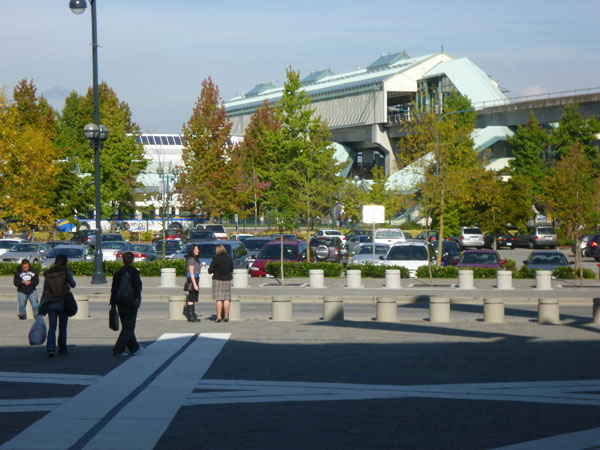 Witold Rybczynski
Witold RybczynskiSkytrain station, Surrey, B.C.
The majority of urban Americans live in suburban metropolitan areas, and the challenge of the coming decade will be making the suburbs more urban, that is, making them denser and creating active, concentrated, walkable town centers. To see how this might be done, one must look no further than Surrey, a suburban community in metropolitan Vancouver, British Columbia. Linked to the city and the urban region by Skytrain, an elevated mass transit system, Surrey is no stagnant suburban dormitory; with almost half a million residents, by 2020 its population is expected to surpass that of Vancouver itself. Outside the Skytrain station (left) is a pedestrian plaza leading to Surrey Central City. At first glance the complex looks like a shopping mall—but it’s hardly a run-of-the-mill mall.
-
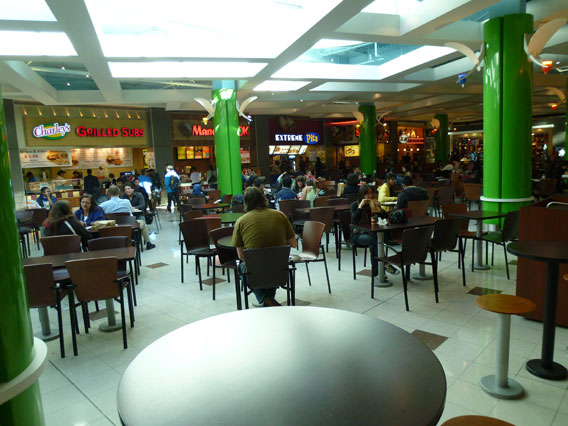 Witold Rybczynski.
Witold Rybczynski.Food court.
If you drive to Surrey, as I did, the first thing you see when you exit the parking garage into the mall is a food court. Nothing unusual here, except that a lot of the diners seem to be college students. This particular food court does double duty as a student cafeteria, for Surrey Central City is also home to a college campus, a satellite of Simon Fraser University.
-
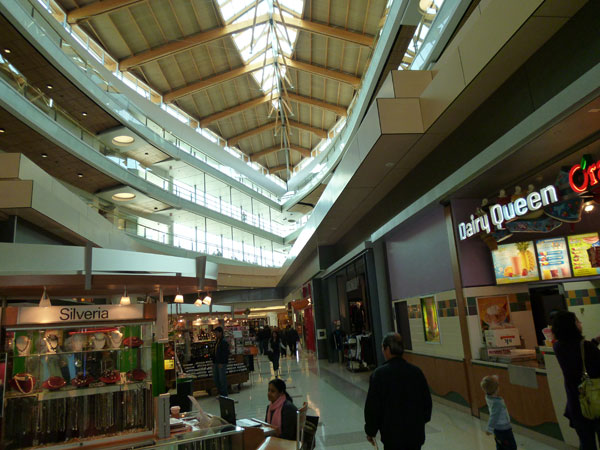 Witold Rybczynski.
Witold Rybczynski.Interior shopping concourse.
Walk though the food court and you get to a typical long shopping concourse lined with the usual chain stores. But look up and you see a soaring space roofed by hi-tech timber trusses and skylights. Those are not shoppers up there but students. The university is on top of the mall.
-
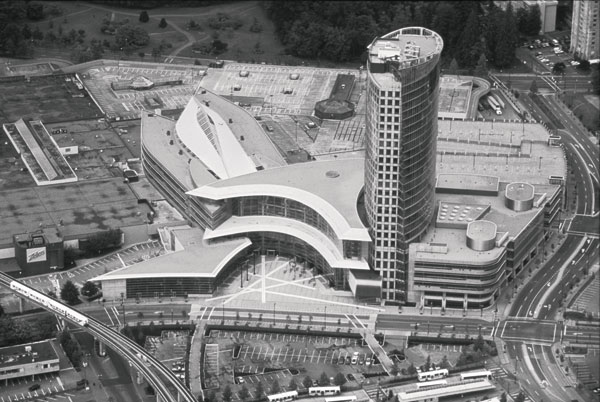 Photo by Nic Lehoux, courtesy Bing Thom Architects.
Photo by Nic Lehoux, courtesy Bing Thom Architects.Surrey Central City, aerial view.
Bing Thom Architects brokered the complicated deal that produced Surrey Central City. Engaged by the city of Surrey to study a future town center, BTA convinced a provincially owned auto insurance company called ICBC (which happened to be looking for a suburban location for its operations) to buy an ailing shopping mall in the center of Surrey, add a 25-story office building (left), and build a college campus that could be leased back to the university. The new population of students and office workers would revive the mall. Existing mall facilities such as the food court and parking lots could do double duty for students and shoppers, and the adjacent Skytrain station and bus terminal would serve commuting students and office workers. The key to the design of the project was placing the 5,000-student, four-story university facilities on top of the shopping mall, which allowed the new construction to proceed while the mall remained open.
-
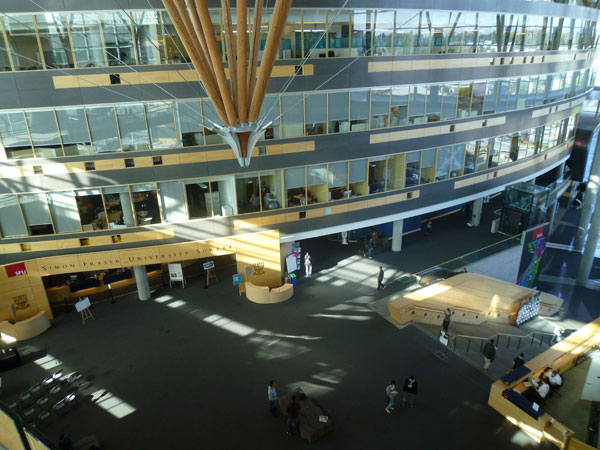 Witold Rybczynski.
Witold Rybczynski.Campus center.
Every campus needs a center, and here it is not a quadrangle or a college green but an interior atrium that also serves as the entry to the university. A conical timber-and-cable truss (left) supports the roof and a circular skylight. The overlooking offices actually belong to the high-rise tower, although they are leased by the university as overflow space. The atrium is separated from the mall by only a flight of broad stairs, for Surrey Central City is planned like a traditional downtown. Just as in a city, different uses are in close proximity, and circulation is continuous rather than separated.
-
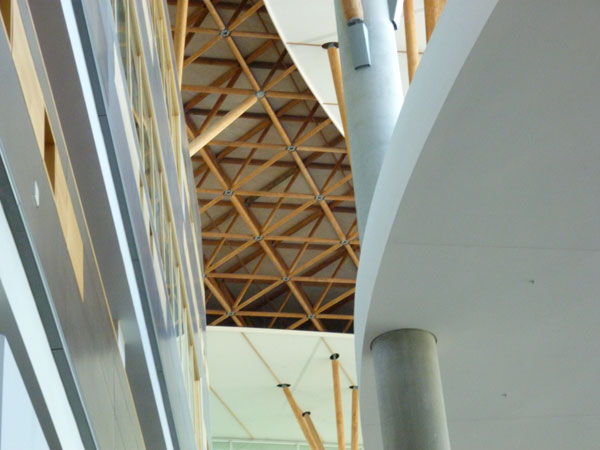 Witold Rybczynski.
Witold Rybczynski.Timber roof structure.
The roof structure of the atrium is fabricated from so-called peeler cores, the wood cylinders left over when plywood layers are “peeled” from a log. The tall structural columns are made out of Parallam, an engineered wood product made from parallel veneer strands bonded with adhesive. These timber elements give a distinct character to the university portions of the town center, setting it apart from a conventional shopping mall. The innovative use of wood is an architectural trademark of BTA, which last year designed the acclaimed Arena Stage in Washington, D.C.
-
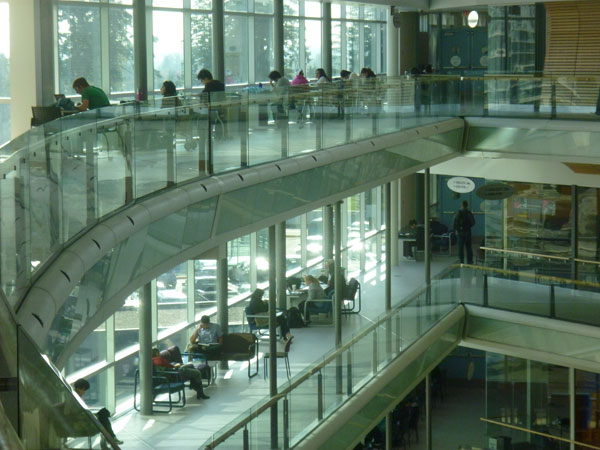 Witold Rybczynski.
Witold Rybczynski.Study areas.
Ivy-covered walls and green lawns have traditionally been the hallmarks of campus life, so the juxtaposition of study halls and stores comes, at first, as a shock. While universities often talk about coming down from their Ivory Towers, there is usually an arm’s-length relationship between the academy and the world of commerce—even college bookstores are generally relegated to the campus fringe. But why should students be isolated from everyday life? Or vice versa? The longer I walked around Surrey Central City the more convinced I became of the profound correctness of this innovative solution.
-
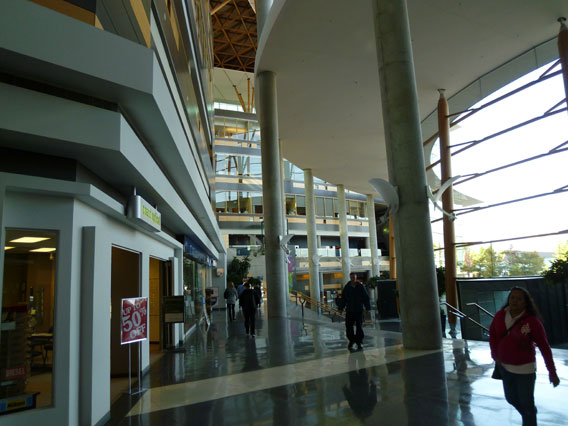 Witold Rybczynski.
Witold Rybczynski.Entrance lobby.
Mixed-use has become the fashionable mantra among planners and real estate developers. However, mixed-use projects are often characterized by separation rather than integration: separate wings, separate entrances, separate circulation. Surrey Central City is different. Shoppers, office workers, commuters, and students all use the same front doors and the same lobby. Unlike conventional malls, which tend to be introverted, the new town center is oriented to the outside through a tall glazed wall overlooking a plaza that is the site of public events connected with the Surrey community as well as the university and the shopping mall.
-
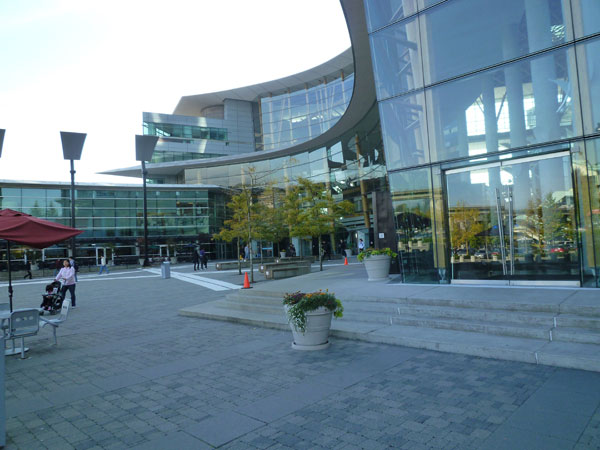 Witold Rybczynski.
Witold Rybczynski.Plaza.
Why has Surrey Central City succeeded when so many publicly funded development projects fail? One reason is the backgrounds of the individuals involved. The chairman of ICBC, Bob Williams, was a city planner by training and a former politician; Bing Thom combines award-winning design skills (he received the 2011 Royal Architectural Institute of Canada Gold Medal) with extensive experience as a real estate developer; and the activist mayor of Surrey, Dianne Watts, recently elected to a third term, is a former businesswoman. Another reason is Canadian pragmatism, the same pragmatism that has made the city of Vancouver a poster child for public urban design regulations that have created an attractive, livable city without thwarting private initiative.